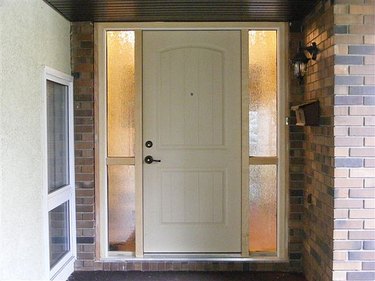
A deadbolt is a hardware device to secure an exterior door. It may be used alone or in conjunction with a traditional lockset to add extra security. Deadbolts are harder to tamper with than regular latch bolts, making them an effective tool against burglaries.
Components
Video of the Day
A deadbolt consists of only a few basic parts. The largest is the lock body, which is a cylindrical casing that holds all of the locking components in place. A cylinder is located within the casing, and has a keyhole connected to a series of internal pins. When the correct key is inserted, the pins will align and allow the lock to open. The interior side of the cylinder is operated by a small knob called a thumbturn, which locks or unlocks the door. Both the cylinder and thumbturn can control the bolt or latch, which passes through the door into a strike on the frame to secure the opening.
Video of the Day
Types
Deadbolts come in a number of varieties to work in different applications. They can be single or double cylinder versions, which have two keyed cylinders rather than a thumbturn on one side. Exit-only units don't have a keyhole on the outside, and are often used as privacy locks in bathrooms. Classroom deadbolts allow the lock to be unlocked using the thumbturn, but cannot be locked without the key. This prevents a child from locking himself in a room.
Function
The most common function for a deadbolt is as an auxiliary lock on a door. This means that the door is secured by a regular latch bolt, but also by a separate deadbolt. A double cylinder deadbolt is used in homes with glass panels on or near the door. If a burglar breaks a window, he will be unable to reach in and turn the thumbturn on the inside of the door. Many deadbolts are used in interconnected lock units, such as those found in apartments and dorm rooms. From the outside, two keys are needed to unlock the deadbolt and knob. From the inside, however, both the deadbolt and latchbolt are retracted at the same time when the door knob is turned.
Considerations
Traditional deadbolts have standard cylinders where a series of pins must align to unlock the door. Most locksmithing tools can be used to pick these locks fairly easily. To increase the security of your home, look for high-security deadbolts. These locks feature patented keyways that may be angled, rotating or otherwise designed to resist picking. Choose locks made from steel to decrease the risk of sawing or drilling. Look for deadbolts longer than 1 inch to prevent prying or jimmying.
Installation
Most deadbolts are installed through a small hole in the door located several inches above the doorknob. The average door will not have this hole predrilled, so you'll need to use a hole saw to create this opening. Use templates provided with the lock to locate and cut a hole, then place the deadbolt into the opening. Slide the cylinder into the front of the lock and connect it to the thumbturn by clicking the two pieces together. Use a chisel to create a pocket in the frame to accommodate the deadbolt, then cover this pocket with the strike plate to complete the installation.